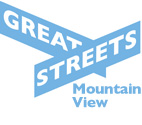by jarkatmu | Mar 16, 2013 | California Street, City Council, Events, Press
We hope you joined us on March 2nd for GSRP’s first ever bike tour of our area! More than 40 community members attended including councilmembers Ronit Bryant and Margaret Abe-Koga, Environmental Planning Commissioner Margaret Capriles, and Community Development Director Randy Tsuda. I could tell you all about it but we received three write-ups in local papers. Check out the articles and take a gander at the tour brochure to get a sense of the ride if you could not join us. If you did join us, you might want to read articles from the Mountain View Voice and the San Jose Mercury News to see if you are in the pictures or mentioned in the articles.
Special thanks to the speakers who shared their experiences on the tour: Valeria Craven, Howie and Dana Meyerson, John and Karen Farrell from Bumble Bee Health Foods, Elena Pacheco, Ariel T. Mendez, Thida Cornes, and Jack Miller. We would also like to thank Google for providing loaner bikes and the Silicon Valley Bicycle Coalition for providing liability insurance. Safe Moves was also in attendance to share information on the city’s bike education program at schools!
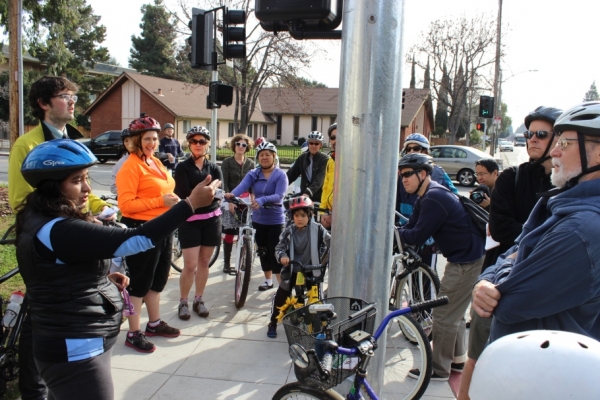
Tour attendes listen to Valeria Craven, left, as she describes the danger crossing the Escuela and California Intersection. Photo By Daniel DeBolt, Mountain View Voice.
At meetings on the Tuesday and Wednesday following the tour, Councilmembers and the Bicycle and Pedestrian Advisory Committee discussed funding for bicycle and pedestrian safety projects in the context of the crucial Capital Improvement Program (CIP) list.
CIP projects are items that City Council deems important to the City of Mountain View and are prioritized annually. The projects cost over $50,000 and cover needs such as improved Fire Department Communication systems and upgraded methane release valves in North Bayshore to street safety projects such as the potential road diet for California Street and bike lanes on Escuela Avenue.
During the Council meetings, elected officials and members of the public spoke strongly in support of projects that improve safety and livability, some even cited the bike tour and newspaper articles. Ultimately, California Street and Escuela Avenue made it into the CIP list! The city will examine a range of alternatives to improve the safety and aesthetics of both streets and the Great Streets Rengstorff Park road diet proposal for California Street will likely be in the mix.
Councilmembers also spoke strongly in favor of allocating funding for immediate short-term improvements such as new striping and improved lighting.
The CIP list must still go through a final round of Council review in May, but we’re over the first hurdle and are ecstatic with Council’s enthusiasm for crafting safer, more livable streets in the Rengstoff Park area along with other parts of the city.
We will need your help leading up to the critical City Council funding meeting in May (Date TBD). If you are interesting in meeting individually with councilmembers, please contact us. However, attending the meeting is the most effective way of voicing support for safer, livable streets in the Rengstorff area. We know it can be difficult to find time for a Council meeting, but they are usually scheduled in the evening around 6PM on a Tuesday. If you attend just one council meeting, this is the one to attend.
The city hasn’t nailed down the meeting date yet but we will let you know through our newsletter as soon as we know. Please sign up for our newsletter if you haven’t already and we hope to see you in May!
by jarkatmu | Sep 5, 2012 | California Street, Press
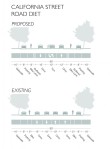
Before and After Street Section for California Street
As mentioned in the last post, the Great Streets Rengstorff Park project is was highlighted in the Mountain View Voice, with a focus on the safety improvements that are urgently needed for California Street following the tragic case of reckless driving that killed William Ware.
Judging from the comments, there was a lot of interest in the idea, but there were questions about California Street’s ability to function with two car lanes and one turn lane, instead of four car lanes. I thought it would be appropriate to go into a bit more detail about how the road diet can successfully work and why it’s good for California Street.
Capacity Isn’t Reduced
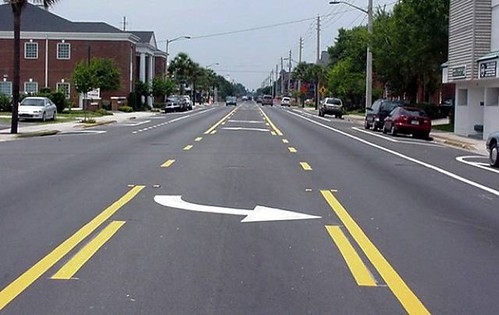
The new center turn lane is what makes road diets work for drivers and improves capacity.
According to research on lane reductions from around the country, streets that cary less than 20,000 cars per day are good candidates for road diets. These streets don’t cause spillover onto nearby streets because the new center turn lane improves capacity. The most recent City of Mountain View traffic data states California Street caries approximately 11,400 vehicles per day, well within the paramaters of a road diet.
While spillover vehicle traffic is an important factor, it should not be the only criteria for considering a road diet. Road diets substantially improve safety, make streets more livable, and provide extra space for safer movement of cyclists and pedestrians.
It’s Not Just About Cars
According to a study from the Federal Highway Administration (FHWA), road diets are proven solutions for safer streets, because they reduce vehicle speed and minimize conflicts that arise from multiple lanes, numerous driveways, and many pedestrian and bicycle crossing areas. The FHWA studied roads similar to California Street that went on a “diet,” and there was a 19 percent decrease in total crashes, described as “a substantial difference,” after controlling for changes in traffic counts.
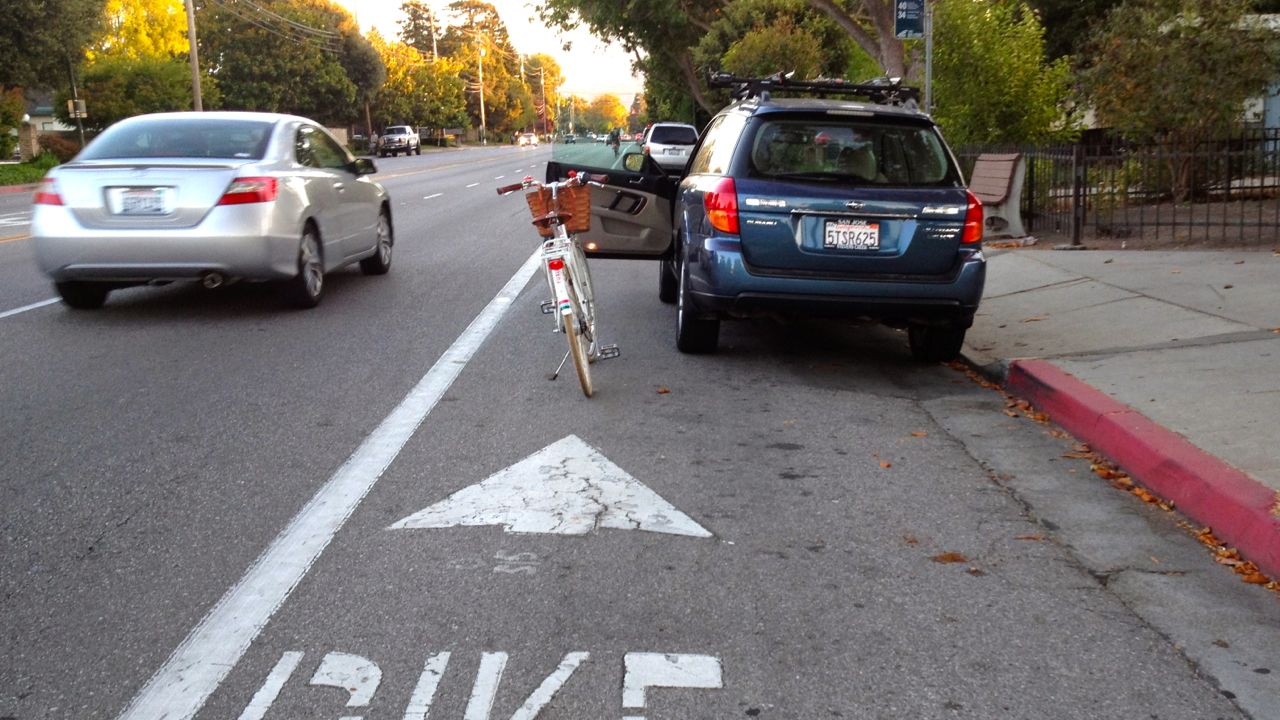
Many bike lanes in Mountain View, including those on California Street, are dangerously striped in the “door zone.” The road diet will allow wider bike lanes so doors aren’t a hazard, making for a low-stress riding experience. Source: Janet LaFluer
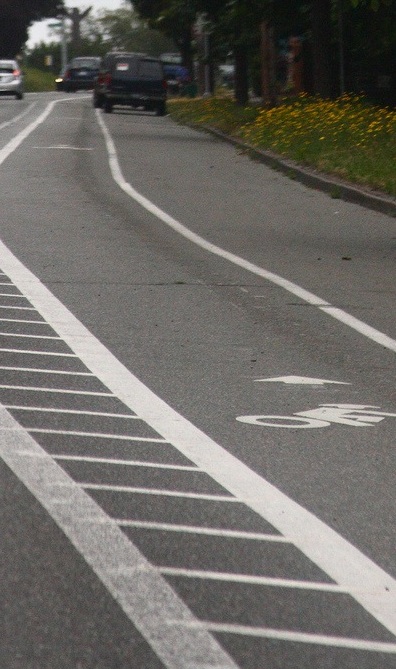
The road diet would allow for wider bike lanes with a painted buffer. Source: Will Vanlue
The extra space can also accomodate wider bike lanes that are safer and make cycling a more attractive transportation option. The existing bike lanes on California Street are within what’s called the door zone, which means if a person in a parked opens their door without looking, a cyclist may collide with the open door or be forced to swerve into the traffic lane. Both outcomes can lead to injury or death, and cyclist riding in a door zone lane must constantly fear for her safety since every parked car is a potential hazard.
For pedestrians, the additional space are perfect for “bulb outs,” which reduces the crossing distance between sidewalks at intersections, minimizing risk. Additionally, the curb corners can be tightened so vehicles can’t carelessly speed around corners, ignoring and potentially endangering those in the crosswalk.
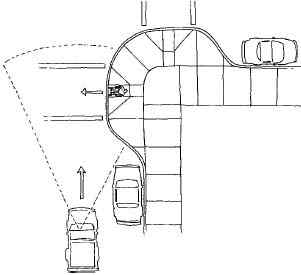
Bulb outs not only shorten the crossing distance for pedestrians, but increase visibility. Source: FHWA
Future Traffic Increase?
In reference to the California Street road diet, Public Works Director Mike Fuller is quoted in the Voice: “But with the projected future (traffic) volumes, we may not be able to.” The projections he’s referring to are in the city’s new General Plan, which is based on a conservative model that assumes minimal reduction in driving by 2030. However, increases in car traffic are not an inevitable force of nature. Building safer, more accessible streets that provide a range of transportation options are key to making the city more livable and improving the quality of life.
UPDATE 9/9/12: The original link to the FHWA study was incorrectly linked to an earlier 2004 study that concluded road diets had limited impact on safety. The FHWA did a follow-up study in 2010 with a more detailed statistical model and found that road diets do have a positive impact on safety. The link in the article has been changed to the 2010 study.

